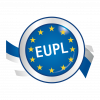The new version 1.2 of the European Union Public Licence (EUPL) is published in the 23 EU languages in the EU Official Journal: Commission Implementing Decision (EU) 2017/863 of 18 May 2017 updating the open source software licence EUPL to further facilitate the sharing and reuse of software developed by public administrations (OJ 19/05/2017 L128 p. 59–64 ).
What is changed in the new licence?
EUPL v1.2 has a wider coverage: it cover “the Work” (meaning copyrighted work) and not exclusively “the software”. Therefore it is easier to apply the EUPL v1.2 to related documentation, handbooks, standard specifications etc.
EUPL v1.2 has a wider compatibility: the software itself (copies or modifications/improvements) will stay covered by the EUPL without possibilities of re-licensing by recipients, but it may also be merged in a new – other - larger work with other software components covered by compatible licences. When needed and for avoiding licence conflicts, this other derivative work can then be distributed under the compatible licence. The list of compatible licences includes both the GPLv2 and v3, the AGPL, MPL, EPL, LGPL and other licences. Regarding documents, compatibility includes the Creative Common licence CC BY SA.
The purpose of this compatibility list is not to endorse or recommend the listed licences: it is finding interoperable solutions to possible licence conflicts. This is the reason why the list includes SA (share alike) or copyleft licences, and not the most permissive ones.
EUPL v1.2 (article 9) provides more flexibility concerning the additional agreements: any additional provision that is not in contradiction with the licence is valid, including the selection of a specific applicable law, of a specific arbitration court etc.
EUPL v1.2 has adapted its terminology to the evolution of European law and has now a Croatian working version
Does it apply to projects already covered by EUPL?
In case a work is currently licensed “under the EUPL” or “under the EUPL v1.1 or later”, the new EUPL v1.2 applies. In case a work is licensed “under the EUPL v1.1” (sometimes adding “v1.1 only”) no automatic update is foreseen. The project owner is invited to check the opportunity of updating its notices.
Is the EUPL copyleft (or "share alike / reciprocate")?
The EUPL is copyleft: if the original work, even modified or improved, is re-distributed, the same licence must be applied. However, in case the covered code is merged with code obtained under a compatible licence, this compatible licence may be applied to the derivative work in case of distribution. Since the list of compatible licences includes the MPL, the EPL, the LGPL and more other licences, is the “copyleft” of the EUPL v1.2 weaker than before?
On one hand, the extension of the compatibility list may reflect the feeling that “we do not need strong copyleft licences anymore” because the free/open source software implementation is strong enough and because the pretention for extending the coverage of a licence in the case of linking has caused more fears than benefits. However, the EUPL provisions mandating the reciprocal provision of the source code of a distributed derivative, even in the case of network distribution, will persist after a compatible licence is applied to this derivative. Indeed, article 5 of the EUPL states that the compatible licence will prevail in case "Licensee’s obligations under the Compatible Licence conflict with his/her obligations under the EUPL" and none of the compatible licences prohibits such reciprocity, even when not mandating it expressly.
On the other hand, the European law (in particular recitals 10 and 15 of Directive 2009/24/EC on the protection of computer programs) seems to invalidate the idea of “strong copyleft” in the case of linking. According those provisions, any portion of code that is strictly necessary for implementing interoperability can be reproduced without copyright infringement. This means that linking cannot be submitted to conditions or restricted by a so-called “strong copyleft licence”. As a consequence, linking two programs does not produce a single derivative of both (each program code stay covered by its primary licence). Therefore the question is answered by the Directive: the EUPL v1.2 is copyleft (or share-alike) for protecting the covered software only from exclusive appropriation, but it has no pretention for any “viral extension” to other software in case of linking.
Is the EUPL v1.2 convenient for distributing libraries, like the LGPL?
The EUPL v1.2 looks more “adaptable” than the previous version. Article 9 EUPL v1.2 authorises extending the licensed rights. In case the normal exploitation of the licensed program is to be used as a “library” which generates code for building other more specific software, and in case the licensor does not want to impose open source licensing if such resulting software is distributed, the licensor may, according to article 9 EUPL, extend the licensed rights in the matter of compatibility (article 5 – compatibility clause). The recommended copyright notice is as follows:
“Copyright: <author> <date>; Licensed under the EUPL, with extension of article 5 (compatibility clause) to any licence for distributing derivative works that have been produced by the normal use of the Work as a library.”

